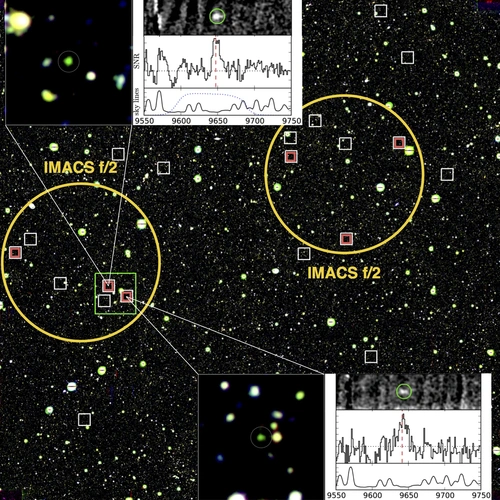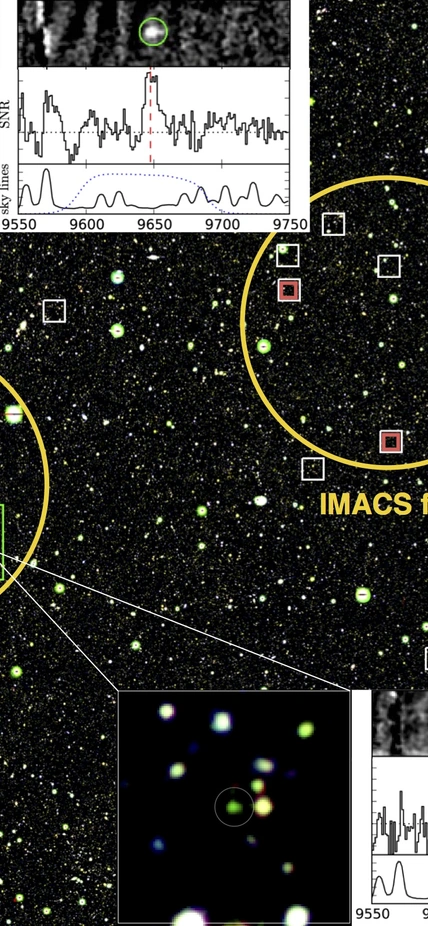Washington, DC— New work from a research team including the director of Carnegie’s Las Campanas Observatory, Leopoldo Infante, has tripled the sample size of known galaxies that can teach scientists about a key period in the universe’s history, when the lights came back on after the so-called dark ages. Their work, which was conducted using the Inamori Magellan Areal Camera and Spectrograph on Carnegie's Magellan telescope at Las Campanas, is published in The Astrophysical Journal Letters.
The Big Bang’s explosion scattered a hot, murky soup of particles throughout the universe. About 400,000 years later (very quickly on a cosmic scale), these particles cooled and coalesced into neutral hydrogen gas, which is opaque, giving off no light. The universe stayed dark until the gravity condensed matter into the first stars and galaxies. The energy released by these ancient galaxies caused the neutral hydrogen strewn throughout the universe to get excited and ionize, or lose an electron, a state that the gas has remained in since that time. This is when the universe became largely “transparent” to the passage of light and thus luminous again. Itis called the epoch of reionization.
Astronomers are very interested in probing the period when most of the reionization is thought to have taken place, about 800 million years after the Big Bang. But one of the most-important tools for studying this, so-called Lyman-alpha emitting galaxies, are extremely difficult to find and confirm from the time in which reionization occurred.
Studying the light from these galaxies can teach astronomers about the free hydrogen floating in space that it passes through on its way to be seen by observers on Earth, so astronomers use it to try and learn about the switch from neutral hydrogen gas to ionized hydrogen that occurred during reionization.
The team used an ongoing survey of Lyman-alpha Emitting Galaxies from the End of Reionization (LAGER) to select 23 possible candidate galaxies and was able to follow-up with spectroscopic observations of 12 of them, using the Magellan telescopes at Las Campanas. They identified six of the candidates as the exact kind of galaxy they were seeking.
“The success rate of the identification is very encouraging,” said lead author Weida Hu. “Especially because the signals from the three targets are beyond the expected detection limit due to moonlight pollution.”
“What’s more, our latest results support our earlier analysis of the candidates led by Zhenya Zheng of the Shanghai Observatory that indicated reionization is around 50 percent complete at this epoch, and may have occurred in patches, not uniformly,” explained Junxian Wang of the University of Science and Technology of China.
“Tripling the number of known galaxies from the period when the bulk of reionization was thought to occur will really help us better characterize and constrain the period,” added Infante.
“It is remarkable that three of the galaxies are very bright in their Lyman-alpha emission, the brightest among known galaxies ever confirmed at this and earlier cosmic epoch,” said Sangeeta Malhotra of the Arizona State University.
The next stages of the project will involve searching in a larger volume and probing the physical nature of these galaxies.
Other co-authors include: James Rhoads, Alicia Gonzalez, Vithal Tilvi, and Huan Yang of Arizona State University; Alistair R. Walker of Cerro Tololo Inter-American Observatory; Linhua Jiang of The Kavli Institute for Astronomy and Astrophysics; Chunyan Jiang of the Shanghai Astronomical Observatory; Pascale Hibon of the European Southern Observatory; L. Felipe Barrientos and Gaspar Galaz of Pontificia Universidad Católica de Chile; Steven Finkelstein of University of Texas Austin; Wenyong Kang and Xu Kong of the University of Science and Technology of China; and XianZhong Zheng of the Chinese Academy of Sciences.

Astronomers identified six distant galaxies (small red boxes) from 780 million years after the Big Bang with two Magellan IMACS pointings (yellow circles plotted in the false-color image of a two-square-degree region of the LAGER field, and the small white boxes mark the positions of pre-selected candidates). Two- and one-dimensional IMACS spectra for two of the brightest Lyman-alpha emitters are given as examples, together with the zoomed image insets (5” in diameter). The clustering of Lyman-alpha emitters in the green box is remarkable, says the team. They likely sit in a common cosmic ionization bubble.
Image is courtesy of Zhen-Ya Zheng (SHAO) and Wei-Da Hu (USTC).
Acknowledgements
This research was supported by the National Science Foundation of China, the National Program for Support of Top-notch Young Professionals, the National Basic Research Program of China, the CAS Frontier Science Key Research Program, the China-Chile Joint Research Fund, the CAS Pioneer Hundred Talents Program, the U.S. National Science Foundation, CONICYT-Chile, and the Shanghai Municipal Natural Science Foundation.
